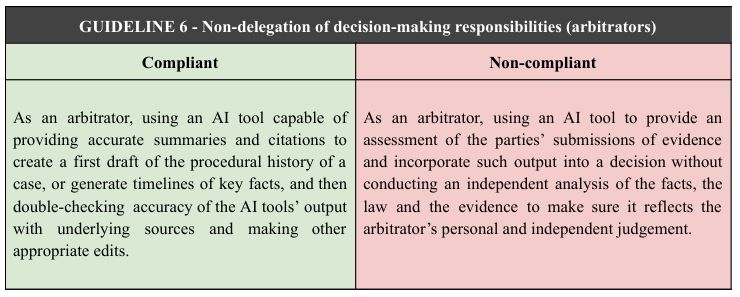Artificial Intelligence (AI) is the ability of a computer or computer-controlled robot to perform tasks that are commonly associated with the intellectual processes characteristic of humans.1
With the appearance of AI, many fear that computers will take over the work of human workers, especially in fields where a computer can actually perform better. An example of such a field is legal work, where a study has shown that the capabilities of AI far exceed those of human lawyers in certain aspects. For instance, an AI is capable of drafting five NDAs in 26 seconds with an accuracy of 94.55%, whereas lawyers needed at least an hour and achieved an average accuracy of 84.84%.2
AI in its current state, however, is far from perfect. This was showcased when two US lawyers were fined USD 5,000 because they relied on AI to come up with case law for one of their submissions. The cases ChatGPT referenced did not exist, although ChatGPT assured the lawyers the cases were real.3 This example clearly shows the underlying dangers in the use of AI in litigation and international arbitration.
Regulation of AI in International Arbitration
Currently, as in almost every other field, the use of AI in arbitration proceedings is mostly unregulated. Therefore, arbitration lawyers must approach this new technology with caution.
The pioneer in the regulation of AI in legal work is the Silicon Valley Arbitration & Mediation Center (SVAMC), a forum specializing in technology-related dispute resolution. In August of 2023, SVAMC published its Draft Guidelines on the Use of Artificial Intelligence in International Arbitration (the "Guidelines"). These guidelines have not yet been adopted but were only made publicly available in a draft form so that practitioners can provide feedback and comments before the final version is published.
The Guidelines contain rules addressed to the parties, their legal representatives and arbitrators. It also differentiates between compliant and non-compliant utilization of AI, the latter being essentially the use of AI without human input and an assessment of the results to select arbitrators and draft submissions or awards. For instance, arbitrators must still conduct an independent assessment of the facts, the law and the evidence:

AI Tools Currently Used by International Arbitration Lawyers
AI can already be used in international arbitration in several different aspects of legal work.
To conduct legal research, international arbitration lawyers can use AI to complement their own work and speed up certain parts of the process. AI, however, currently does not allow fully automated research. Platforms such as Jus-AI (by Jus Mundi), Lexis+ AI (by LexisNexis) and Westlaw Edge (by Thomson Reuters) have already been introduced to the public. Jus-AI uses ChatGPT as its engine and provides a centralized platform where the AI responds to questions based on the Jus Mundi database. Lexis+ AI can do the same, but it is also able to draft arguments, contract clauses and client communications, as well as analyse and summarise the content of documents. Westlaw Edge is a boosted version of the well-known Westlaw research tool, which also provides litigation analytics with detailed information on judges, courts, damages, attorneys and case types. It also features a so-called "KeyCite Overruling Risk" assessment, which warns its user when a "point of law has been implicitly undermined based on its reliance on an overruled or otherwise invalid prior decision."4
For one of the first steps of the proceedings, the selection of arbitrators, lawyers can also use tools such as Arbitrator Intelligence, which allows practitioners to share information and feedback about arbitrators without breaching the confidentiality of proceedings or awards. To achieve this, Arbitrator Intelligence does not collect data that would identify the case or the parties. Instead, it asks for information that facilitates the analysis of decision-making and overall case outcomes of certain arbitrators.
International arbitration lawyers typically work with documents in a variety of different languages. DeepL is an AI-powered tool using artificial neural networks that can dramatically speed up the initial translation of foreign-language documents. While the translation tool of Google (Google Translate) is improving, tools such as DeepL are currently more reliable. DeepL, at the time of publication of the current note, can translate to and from 27 different languages with high accuracy while also learning from its previous mistakes and the user's inputs.
Some lawyers have also applied AI in international arbitration for drafting purposes. Apart from the tools listed above, lawyers sometimes rely on ChatGPT to draft certain parts of submissions or contract clauses. This must be approached with caution, however. Artificial Intelligence, in its current state, is famous for not being able to differentiate between correct and incorrect information. It also invents information (known as AI hallucinations) to fill in the gaps in its knowledge.5 This is a key reason why reliance on AI to draft submissions in international arbitration cases without proper human intervention will amount to non-compliant use of Artificial Intelligence under the SVAMC Guidelines and should be avoided.
Privacy Issues with the Use of AI in International Arbitration
One of the crucial issues with using Artificial Intelligence for legal work is the consideration of data privacy. While most of the above tools provide an elevated level of data security to their subscribed users, uploading confidential information to these platforms can still be problematic. It is important to consider that these AI models continuously "learn" from new data shared with them and can also remember and reuse previously processed information. Sharing unredacted legal documents, therefore, can lead to severe issues and even violations of regulations like the GDPR.6
Conclusion
There are significant hazards associated with using AI in international arbitration and other legal tasks in its current condition. Serious errors can occur in the absence of sufficient human oversight and input. As a result, extreme caution is required. On the positive side, this also means that lawyers cannot (at least for a while) be replaced by Artificial Intelligence. Rather, AI can provide legal professionals with new tools to make certain aspects of their work more efficient.
Footnotes
1 Britannica, artificial intelligence, Nov 2023, https://www.britannica.com/technology/artificial-intelligence (last accessed 24 November 2023).
2 Lrz.legal, Artificial Intelligence vs. Human in the Legal Profession – AI vs. Legal Profession, May 2018, https://lrz.legal/de/lrz/artificial-intelligence-vs-human-in-the-legal-profession (last accessed 24 November 2023).
3 The Guardian, Two US lawyers fined for submitting fake court citations from ChatGPT, June 2023, https://www.theguardian.com/technology/2023/jun/23/two-us-lawyers-fined-submitting-fake-court-citations-chatgpt (last accessed 24 November 2023).
4 Thomson Reuters, Two US lawyers fined for submitting fake court citations from ChatGPT, https://legal.thomsonreuters.com/en/products/westlaw-edge/features (last accessed 24 November 2023).
5 Scribbr, Is ChatGPT Trustworthy? | Accuracy Tested, November 2023, https://www.scribbr.com/ai-tools/is-chatgpt-trustworthy/ (last accessed 24 November 2023).
6 Legalfly.ai, Legal AI: The Unseen Data Privacy Risks, August 2023, https://www.legalfly.ai/blog/data-privacy (last accessed 24 November 2023).
The content of this article is intended to provide a general guide to the subject matter. Specialist advice should be sought about your specific circumstances.

